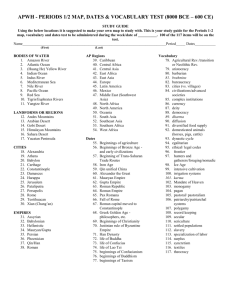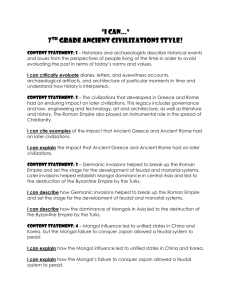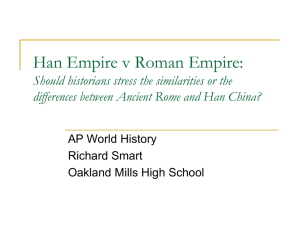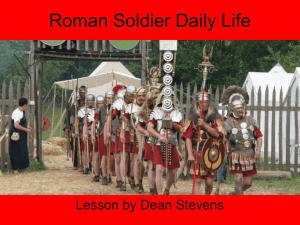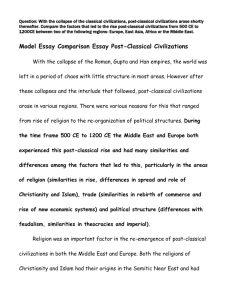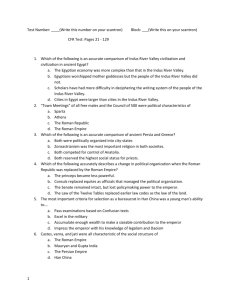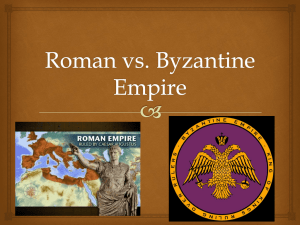8000 BCE – 600 CE
advertisement
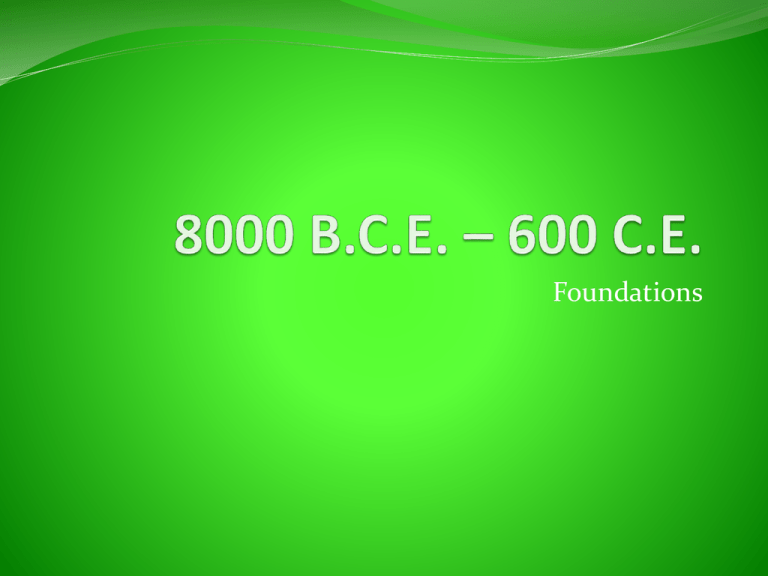
Foundations 8000 B.C.E. – 600 C.E. Major Developments Neolithic Revolution / Development of Agricultural societies Changes in gender relations due to Neolithic Rev. Development of major belief systems (all EXCEPT Islam) Major migrations (Bantu, Huns, Germans, Polynesians) Early Civilizations Mesopotamia, Egypt, Indus, Shang, Olmec, Chavin Classical Civilizations (600 B.C.E. – 600 C.E.) China, India, Mediterranean, Mesoamerica Collapse of Classical Empires Han China, Western Rome, Gupta India Continuities 8000 B.C.E. – 600 C.E. Gatherer-Hunter Societies Nomadic Societies Major Civilizations 8000 B.C.E. – 600 B.C.E. Mesopotamia – Tigris and Euphrates Rivers Egypt - Nile River Indus Valley (Harrapan) - Indus River Shang - Huang He/Yellow River Mesoamerica: (Olmec – No River!) Andean South America: (Chavin – No River!) Major Civilizations 600 B.C.E. – 600 C.E. China: Han India: Gupta Mediterranean: Greek and Roman Mesoamerica: Olmec 8000 B.C.E. Beginnings of Agriculture 3000 B.C.E. Beginnings of Bronze Age Beginnings of Early Civilizations 1300 B.C.E. Iron Age (mostly 500s) th 6 Century B.C.E. Beginnings of …. Confucianism (Confucius) Buddhism (Siddhartha Guatama – The Buddha) Taoism (Lao Tsu) (mostly 400s) th 5 Century B.C.E Greek Golden Age 323 B.C.E. Alexander the Great 221 B.C.E. Qin unified China 32 C.E. Beginnings of Christianity 180 C.E. End of Pax Romana 220 C.E. End of Han China 333 C.E. Roman capital moved to Constantinople (300s) th 4 Century Beginnings of Trans-Saharan Trade Routes 476 C.E. Fall of Rome 527 C.E. Justinian Rule of Byzantine Empire no written documents vs. written proof of history Old Stone Age Nomadic, small communities and population, economic distribution is more equal start of agriculture Live with husband’s family Trace through father’s lineage Farming system where animals are taken to different locations in order to find fresh pastures to look at the world primarily from the perspective of one's own culture Looking for food process by which people take an area of land to use for agriculture, only to abandon it a short time later a region in the Middle East incorporating present-day Israel, West Bank, and Lebanon and parts of Jordan, Syria, Iraq and south-eastern Turkey. system of writing used by the Ancient Egyptians, using a combination of logographic, syllabic, and alphabetic elements. group of peoples that occupied lands stretching from the British Isles to Gallatia. Went to war with Romans. United Ancient Greece; Hellenistic Age, conquered a large empire. legendary early Greek poet and traditionally credited with authorship of the major Greek epics Iliad and Odyssey Along with Plato, he is often considered to be one of the two most influential philosophers in Western thought. He wrote many books about physics, poetry, zoology, logic, government, and biology. peasants/slaves vs. elite/upper class series of three wars fought between Rome and the Phoenician city of Carthage Reason: clash of interests between the expanding Carthaginian and Roman spheres of influence Roman military and political leader He was instrumental in the transformation of the Roman Republic into the Roman Empire Dictator for life King of the Chinese State of Qin from 247 BC to 221 BC then became the first emperor of a unified China from 221 BC to 210 BC, ruling under the name First Emperor. dominated Japanese politics during the Heian period. people of southern and central India and northern Sri Lanka the most well known of these languages are Tamil, Telugu, Kannada and Malayalam Leader of the Mauryan empire from 273 BC to 232 BC A convert to Buddhism 527 - 565 CE the Eastern Roman emperor who tried to restore the unity of the old Roman Empire He issued the most famous compilation of Roman Law He was unable to maintain a hold in Italy and lost the provinces of north Africa. It was the last effort to restore the Mediterranean unity The social organization created by exchanging grants of lands or fiefs in return for formal oaths of allegiance and promises of loyal service typical of the Zhou Dynasty and the European Middle Ages greater lords provided protection and aid to lesser lords in return for military service Charles the Great Carolingian monarch who established substantial empire in France and Germany (800 C.E) He helped restore some church-based education in western Europe, and the level of intellectual activity began a slow recovering After death, the empire could not survive Formed by the 8th century by exchanging gold from the forests of west Africa for salt/dates from the Sahara or for goods from Mediterranean north Africa Camels were introduced By 3rd century C.E., it rose to power by taxing the salt and gold exchanged within its borders By the 10th century, rulers had converted to Islam and were at its height of power Almoravid armies invaded from north Africa (1076), the power was declining despite the kingdom’s survival new states rose in the 13th century Classic culture emerging in southern Mexico and Central American contemporary with Teotihuacán featured monumental architecture, written language, calendar, mathematical systems, and highly developed religion. developed in the second millennium BCE in the central Andes and the central Pacific coast of South America. included the urbanized cultures of Chavin, Moche, Ica-Nazca, Chimu, Tiwanaku, Aymara, Chachapoya and other Pre-Incan cultures The semi-urbanized Inca conquered greater Peru in the 15th century. Then, in the 16th century, Spain conquered Peru. a Mound-building Native American culture that flourished in the Midwestern, Eastern, and Southeastern United States in the centuries leading up to European contact began to develop around 900 A.D. in the Mississippi River Valley (for which it is named) Cultures in the Tennessee River Valley may have also begun to develop similar characteristics at this point Native American civilization centered around the present-day “Four Corners” area of the Southwest United States. Political regime where most political power effectively rests with a small segment of society (typically the most powerful, whether by wealth, military strength, ruthlessness, or political influence). form of government in which a religion or faith plays a dominant role were not property themselves and could not be sold apart from the land which they worked Worked on the fields of the privileged land owners in return for protection and the right to work on their leased fields belief in, or worship of, multiple gods or divinities the first of the Old Testament patriarchs and the father of Isaac "Judaism, Christianity, and Islam each has a special claim on him" the dispersion of a group of people throughout the world. Examples: Jewish & African Founder/teacher of Taoism (Daoism) record of speeches by Confucius and his disciples, as well as the discussions they held Teacher/founder of Confucianism blessing of Heaven if a king ruled unwisely, Heaven would be displeased and would give this to someone else body of concepts and values which are thought to be held in common by Christianity and Judaism typically considered a fundamental basis for Western legal codes and moral values

